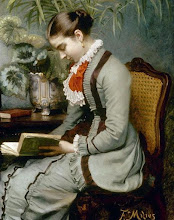Need to see if I can get the sage check organdy sheer done for the HBCP Civil War Event... which wouldn't be hard, since it's in a month, but between then and now, I also need to finish my Early 14th c. Underdress (old one's gotten too small), Early 14th c. Dress Tunic (also good for riding), Early 14th c. Surcoat, Early 14th c. Overgown, and an Early 14th c. woman's 'gardecorps'... It's somewhere between a cloak and a houppelande. From a tapestry from 1298 there's a man's version and a positively charming woman's version in a 1325 painting . My era in Middle Ages reenacting is late 1200s- early 1300s (fashion references like art and tapestries I'm allowed to follow can really be from all of the 13th and 14th centuries because fashion did take a rather noticeable and fast turn around 1300, so the older, looser styles of the 13th c. or the more fitted newer styles of the 14th c. would all work, however if asked the date I stick to "The Year of Our Lord Thirteen Hundred and Nine!" :D ). And I need all those done by, uh, the 22nd. :P
Medieval stuff is pretty simple, even though I hand-sew it, but it's the hand sewn eyelets that take forever. Cross-lacing didn't come in until the mid-Victorian era, and so cross lacing only needs staggered eyelets, but they need to be closer together not to buckle than does cross lacing.
////// (but lacing it underneath like I/\/\/\/\/I )
...not...
XXXXXXX
...going up the designated part of the dress. The underdress needs to get done first- because corsets (called 'bodies' or 'stays' up until the early/mid-1800s) weren't in style during that period in time, women tailored their clothes to hold everything in. A (usually white) linen underdress was created for this purpose- it's not that normal outerwear would not have held, but underdresses often served as sleeves under outerwear with short wider sleeves, cover beneath shorter hems, cover skin beneath wide eyelets or open lacing, or a nice outline above a low or wide neckline. This woman, even though she has hers hiked up (*gasp!*), can be seen utilizing her underdress for all four of the aforementioned purposes- if you look closely you can see the spiral lacing going from her left to right (your right to left).

Sooo...
-1860s Sheer, Sage Organdy
-Early 14th c. Underdress, White Linen
-Early 14th c. Dress Tunic, Dark and Light Green Linen
-Early 14th c. Surcoat, Red Linen
-Early 14th c. Overgown, Blue Linen
-Early 14th c. Woman's Gardecorps, Brown Wool
Fie, this is gonna be expensive...! :P
By the way, an excellent example of a woman's style gardecorps can be seen in the series "Legend of the Seeker". I know, a fantasy show having accurate stuff! *Gasp!* Check it out- of course the neckline would be higher and the cowl beginning a tad closer to the neckline and made of wool and with different closures in the front or even lacing, but fundamentally this is really a very well made gardecorps! It's basically a poncho, cut your arms out, sew up the sides and leave the open sleeves to shelter you like a cape but still leave your arms open. The version on the show was left open at the sides, whereas originals would have been left open near the armscye but sewn together at least at the waist. This would be in the style of the 14th c., more fitted and belted (in the 1325 version with the popular double-wrap belt).

A painting of an original. This is the man's version, and from the 13th c., and as such is a loose, unbelted sack garment. There are of course many variations of the garment, but the man on the right wears one such example.


I like this post very much--TFS!
ReplyDeleteThanks Lisa! The Middle Ages, as I have said before, is my true love. :)
ReplyDelete